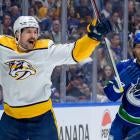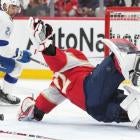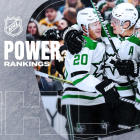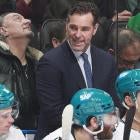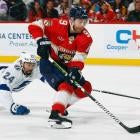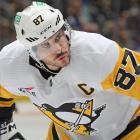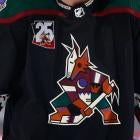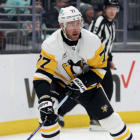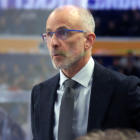
More NHL Offseason: NHL rumors | Rumor mill | Trade Tracker | 2014-15 preseason odds
There's plenty of time remaining in the NHL offseason, but with so much movement before the calendar struck July 15, there's plenty to be gleaned from what has already happened. Big trades, big free-agent signings and the like have created a rather frenetic few weeks of summer without a single puck or skate in sight.
With that in mind, it's time to recap how the landscape and teams around the NHL have changed with Eye on Hockey's Offseason Review. Whipping around all four divisions, the review will cover the offseason additions and subtractions, the money spent and if teams around the league have successfully taken the strides to improve their teams for 2014-15 this offseason.
The top of the Pacific Division was a slugfest last season with the Anaheim Ducks putting together the best record in the conference but the Los Angeles Kings taking home the Stanley Cup. The San Jose Sharks were a regular-season force and like a few other teams had the eventual champs on the ropes before a postseason collapse. All three should remain the favorites to finish in the top three of the division.
With the top of the division remaining particularly strong, the Vancouver Canucks made strides to put a disastrous season behind them and return to playoff contention. The Edmonton Oilers also did what they could to try and bring a seat closer to the big boys' table, while the Calgary Flames made some minor improvements and the Arizona Coyotes reshuffled, but perhaps not enough.
With not a lot left to get done this summer, the Pacific should remain a gantlet for each of its teams, but let's see where they stand as of now ...
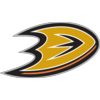 Anaheim Ducks
Anaheim Ducks
In: F Ryan Kesler (trade), D Clayton Stoner (4 years, $13 million), F Dany Heatley (1 year, $1 million), F Louis Leblanc (1 year, two way)
Out: F Nick Bonino (trade), D Luca Sbisa (trade), D Stephane Robidas (UFA), F Teemu Selanne (retirement), F Saku Koivu (UFA), F Daniel Winnik (UFA), F Mathieu Perreault (UFA)
Biggest acquisition: This one is pretty obvious. The trade for Kesler was an aggressive move from general manager Bob Murray. The club needed to improve at the No. 2 center position and did better than they could have on the open free-agent market by trading for Kesler. With Ryan Getzlaf manning the top line and the Ducks being able to counter with a second line centered by Kesler creates matchup headaches for opponents. It was a high price to acquire Kesler, but the Ducks made a notable improvement to their group with this addition and will be better at both ends of the ice for it.
Biggest tasks remaining: The best thing the Ducks can do at this point is focus on their restricted free agents. Defenseman Sami Vatanen started coming into his own last season and should be granted more responsibility in 2014-15, which should mean a decent raise as an RFA. Forward Jakob Silfverberg, a key piece in the Bobby Ryan trade from a season ago, is also due a new contract, while Devante Smith-Pelly is also seeking a new deal. All of those should be relatively easy to get done and each player likely plays an increased role on next season's team.
Review: The Ducks are getting younger, they're getting deeper and they're just plain better. The young goaltending of Frederik Andersen and John Gibson is going to be an interesting season-long experiment. It could be a heated battle in training camp, as well. The Ducks had to spend more than they should have on Clayton Stoner, but he provides a presence on the blue line the Ducks didn't get enough of last season. Toughness is scoffed at in this more analytical era, but Stoner gives the Ducks a bit more edge. It just happens to come at a premium price, which is not ideal. Assuming his minutes are protected, the Ducks should see improvement on the back end. The Kesler trade has a real chance to be a big one in the franchise's plans for this season, but going with a low-risk, short-term deal with Dany Heatley could pay off next season. Heatley sounds particularly motivated to prove he can still play and still score. If he does score, the Ducks are looking pretty good next season.
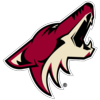 Arizona Coyotes
Arizona Coyotes
In: F Sam Gagner (trade), F Joe Vitale ($3 years, 3.35 million), G Devan Dubnyk (1 year, $800,000), F B.J. Crombeen (trade)
Out: F Mike Ribeiro (buyout), F Radim Vrbata (UFA), F Jeff Halpern (UFA), F Paul Bissonnette (UFA), D Derek Morris (UFA), F Tim Kennedy (UFA), F Andy Miele (UFA)
Biggest acquisition: The three-team trade that brought Sam Gagner to the Coyotes ahead of free agency proved to be the team's biggest move by a long shot. In adding Gagner, Arizona replaces the bought-out Mike Ribeiro at No. 2 center. Gagner showed flashes of brilliance in Edmonton, but could never sustain it either through poor play, bad luck or injury woes. He has never hit 50 points in any of his seven NHL seasons. At 24 years old, there may be more in his game to unlock, but his supporting cast in Arizona isn't a heck of a lot better than what he had in Edmonton, so if it pans out is anyone's guess. The Coyotes gave up very little to acquire him, though, making it worth finding out if he can bring a spark to the lineup.
Biggest tasks remaining: There are no RFAs to re-sign so anything the Coyotes can do, and there's nothing to suggest they will, is going to have to be in trades. After failing to re-sign Radim Vrbata, the Coyotes need to find more scoring, but they may not have the disposable assets to make that happen. That is, unless they're willing to part with Keith Yandle, whose name seems to pop up a fair amount in trade rumors. There's nothing pointing to that happening, though.
Review: From buying out Ribeiro to losing out on re-signing Vrbata, the Coyotes saw a lot of points go out the door. They did well to bring in Gagner at a discounted price via trade and bolstered forward depth with Joe Vitale in free agency. The club also went with a low-risk contract for Devan Dubnyk to see if he can regain his form. Dubnyk likely will have an active competition with Arizona's top goalie prospect Mark Visentin to be the backup. If Dubnyk can hack it, having an NHL veteran as the No. 2 would be a good insurance policy for Mike Smith. In the rough-and-tumble West, the Coyotes don't appear to have the scoring depth to compete with some of the big clubs in the conference and especially within their own division. Unless Don Maloney can work some offseason magic or the kids in the pipeline really step up and help contribute to the Coyotes' roster next season, they're in for another long year.

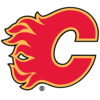 Calgary Flames
Calgary Flames
In: G Jonas Hiller (2 years, $9 million), Mason Raymond (3 years, $9.5 million), D Deryk Engelland (3 years, $8.7 million), F Brandon Bollig (trade)
Out: F Mike Cammalleri (UFA), F T.J. Galiardi (UFA), F Kevin Westgarth (UFA), D Chris Butler (UFA), D Shane O'Brien (buyout)
Biggest acquisition: After last season's failed attempt to replace Miikka Kiprusoff with goalie by committee, the Flames added a proven starter in Jonas Hiller. He had an up-and-down season in 2013-14, eventually being spelled by rookies Frederik Andersen and then later John Gibson in the playoffs. Hiller has hovered around the league average when it comes to save percentage the past three years, often finding himself slightly below the .913 or .914 mark, but he's still an upgrade. Concussion issues derailed Hiller from a promising career it seems, but he looked really good during stretches last season. Though he won't drastically alter the franchise's outlook, he'll help keep them moderately competitive in a tough division and conference.
Biggest tasks left: Like most teams at this stage of the game, the Flames really have to merely focus on re-signing restricted free agents. Issuing a new deal to Joe Colborne, who has filed for arbitration, is the start. Last season was Colborne's first as a full-time NHLer and it went alright enough with 28 points in 80 games. Another big negotiation is with goaltending prospect Joni Ortio, who very well could be the future No. 1 in an organization with several solid goaltending prospects. The rest of the big decisions will come in training camp. Will Hobey Baker winner Johnny Gaudreau make the NHL roster or should he head to the AHL for some additional pro seasoning? The same goes for top pick Sam Bennett, though it appears he will end up playing next season back in junior. The Flames have some decent young players that should push for roster spots this season, which may help improve their outlook for 2014-15.
Review: The Flames had some good and bad this offseason. Shoring up the goaltending situation with Hiller was a big key, but adding some scoring potential and speed with Mason Raymond will also prove helpful. Those two guys are going to be everyday players that contribute. Calgary is also responsible for one of the most curious signings in all of free agency this year. Deryk Engelland's multiyear, multimillion-dollar contract seems to fly in the face of sensibility. Engelland gets an astronomical raise, yet barely was able to crack the Penguins' lineup on a regular basis. If Calgary knows something the rest of the league doesn't, then maybe this pans out, but it was widely panned as one of the worst deals made this offseason and with good reason. Having lost Mike Cammalleri, the Flames are going to need to find more offense. That's going to require some of the youth to step up. Calgary doesn't look a heck of a lot better than it was last season, but the Flames might at least hang around for a bit next season with competent goaltending and some support from the youth.
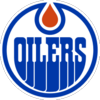 Edmonton Oilers
Edmonton Oilers
In: F Benoit Pouliot (5 years, $20 million), D Mark Fayne (4 years, $14 million), D Nikita Nikitin (trade), F Teddy Purcell (trade), F Leon Draisaitl (draft), D Keith Aulie (1 year, $800,000)
Out: F Sam Gagner (trade), D Anton Belov (KHL), F Ryan Smyth (retired), F Ryan Jones (UFA), D Mark Fraser (UFA)
Biggest acquisition: In terms of money, Benoit Pouliot got the biggest reward of the Oilers' free-agent signings. The hockey nomad had a very good season with the Rangers but Edmonton will be his sixth team since 2006-07. The former fourth overall pick has needed more time than most first-rounders to make it in the big leagues, but a career year and strong playoff performance made him a valuable commodity, but there's no question a five-year deal comes with a lot of risk. That's why the deal to bring Mark Fayne to Edmonton seems like it has a chance to be the best of the bunch. Fayne brings size and smarts to Edmonton's top four and gives the Oilers a shutdown defender who doesn't fit the stereotype of plodding big guy who just hits people and blocks shots. Fayne could easily get 20-plus minutes a night and definitely brings improvement to Edmonton's blue line.
Biggest tasks remaining: The easy job in front of the Oilers is getting No. 3 overall pick Leon Draisaitl under contract. He will be under the entry-level system and will undoubtedly get a max rookie deal. The trickier negotiation at this point is with restricted free-agent defenseman Justin Schultz. With 60 points over 122 games in his first two seasons with the club, Schultz's stock has ebbed and flowed. He clearly has dynamic offensive abilities, but his points-per-game went down last year, his first full NHL season. There's little question that he is an important part of the team's future and at 24 years old should continue to get better as he adjusts to the full-time grind of the NHL. After teammate Jeff Petry signed a one-year deal at a hair over $3 million, the Oilers have to consider how to make a deal that will give them a chance to keep both players around for a few years.
Review: The Oilers made some moves to get better this offseason. Adding Nikita Nikitin and Fayne to a blue line that was average at best last season is an improvement, though probably not an overwhelming one at this point. They should be better as a group, with another good year of Petry and Schultz, once the latter is signed. Trading away Gagner has been a long time coming even though there were so many flashes of promise. That clears the way for Draisaitl to immediately jump to the NHL, joining a host of top young draft picks. Pouliot and Teddy Purcell also bring some energy to the forward group with some offensive pop mixed in. The Oilers are also looking better in net with a full season with the tandem of Ben Scrivens and Viktor Fasth. All in all, the Oilers should be an improved team. Are they good enough to make the playoffs? Probably not, no, but as the young guys continue to mature and develop, the Oilers could be a bit more interesting to watch this season than last (but I think we say that every year).

 Los Angeles Kings
Los Angeles Kings
In: F Adam Cracknell (1 year, $600,000)
Out: D Willie Mitchell (UFA), F Colin Fraser (UFA)
Biggest acquisition: The Kings didn't make any major acquisitions, but that doesn't mean they didn't have a meaningful offseason. The priority coming out of the Stanley Cup win was bringing back Marian Gaborik and did they ever. GM Dean Lombardi signed the veteran forward to a seven-year deal worth $34.1 million. It's an annual paycut from the $7.5 million he was making on his last deal, but that term is ... aggressive, especially given Gaborik's injury history. That said, he clearly fit within the Kings' system and that $4.875 million is a nice cap hit for a top-six goal scorer. The deal is good up front, but Gaborik will be 39 when the contract expires and if his performance goes south, that could be a weighty deal.
Biggest task remaining: The Kings can't do much more at this point, but have to re-sign restricted free agent Dwight King. How they go about doing that with about $1.5 million in cap space (minus some for players that start next season in the AHL) remaining for next season is going to be a challenge. King is set for an arbitration hearing on Aug. 1. Without a new agreement by then, the Kings are playing a dangerous game in terms of what the arbitrator decides King is worth. He's certainly due a raise and likely one that exceeds $1.5 million, so this is a tricky negotiation ahead for the Kings.
Review: Dean Lombardi did everything he could to keep the band together. Aside from losing Willie Mitchell in a cap crunch, he succeeded. Keeping Gaborik keeps continuity up front and fixes a problem that really plagued the Kings in the regular season, which was scoring enough. They were far better in that department in the playoffs. The Kings also have a young replacement for Mitchell in the form of Brayden McNabb, who was acquired in a trade with the Buffalo Sabres last year. He's playing on a $650,000 cap hit next season after re-signing this summer and while mostly unproven, he has promise. The Kings still have their core intact from two Stanley Cup titles in three seasons and have all the pieces to make another run. There will be some tough decisions along the way with players like Justin Williams and Jarret Stoll on the final year of their contracts, but for 2014-15, the Kings are pretty well set and once again one of the best teams in the West.
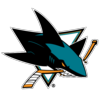 San Jose Sharks
San Jose Sharks
In: F John Scott (1 year, $700,000), F Tye McGinn (trade).
Out: D Dan Boyle (UFA), F Martin Havlat (buyout), D Brad Stuart (trade), F Bracken Kearns (UFA)
Biggest acquisition: This is biggest by actual physical size alone as the team's only unrestricted free agent of note has been John Scott. The Sharks have not done much to alter their roster aside from letting Dan Boyle walk, trading Brad Stuart away and buying out Martin Havlat. That said, the Sharks have been really busy re-signing players, handing new deals to Tommy Wingels, James Sheppard, Scott Hannan and most recently Jason Demers, who very well could be a key player in San Jose's top four defense for the next few years.
Biggest tasks remaining: It seemed as though a complete overhaul of the roster was coming with franchise staples Joe Thornton and Patrick Marleau looking like possible trade bait. That hasn't come to fruition and likely won't at this point as general manager Doug Wilson has backtracked on his assertion the team was going to rebuild on the fly. The Sharks have no RFAs left to re-sign and likely have the roster they're going to head into next season with already.
Review: The puzzling start to summer with talk of rebuilding and doing things differently ended with the Sharks not really doing anything drastic. The collection of tough forwards like John Scott and Michael Haley seems to go outside of the Sharks trying to stay competitive. They weren't in on any of the big free agents or trades. The good news is, the forward group remains one of the league's best. Even though it sounds like Brent Burns is heading back to defense, likely to fill the hole left by Boyle, the Sharks should score quite a bit. There are still pieces in place for the Sharks to put together a run. Perhaps once they get going next season Wilson will make some moves with the playoffs in mind, but as constructed currently, the Sharks have a team worth paying attention to.
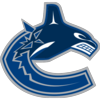 Vancouver Canucks
Vancouver Canucks
In: G Ryan Miller (3 years, $18 million), F Radim Vrbata (2 years, $10 million), F Nick Bonino (trade), D Luca Sbisa (trade),
Out: F Ryan Kesler (trade), D Jason Garrison (trade), F David Booth (buyout), F Mike Santorelli (UFA), F Jordan Schroeder (UFA), D Andrew Alberts (UFA)
Biggest acquisition: The contract doled out to Ryan Miller is certainly a risky one. Giving $6 million a year to a 33-year-old goaltender coming off a disastrous end of the season may not be the most sensible thing. That said, save for the final two months of his 2013-14 campaign, Miller was pretty good. Even in a bad situation in Buffalo, he was still performing at a high level with a .923 save percentage. His age is definitely a concern at this point considering the money as most goalies are essentially in their declining years post-30. The Canucks needed to do something with their goaltending as it didn't seem like Eddie Lack and Jacob Markstrom were going to help them compete consistently enough. Miller probably does a bit better, but it cost the Canucks a great deal to make the move.
Biggest tasks remaining: There's really not much left to do outside of possibly re-signing Darren Archibald and Jeremy Welsh, who spent most of the season in the AHL. Unless new general manager Jim Benning has any more tricks up his sleeve for trades, it seems like we're looking at the 2014-15 Canucks roster as it will be on Oct. 1.
Review: After such a disaster of a season, it seemed like the Canucks were headed toward a rebuild. The moves made this offseason suggest otherwise, rather decisively. The signing of Miller was indicator No. 1, but then the team went out and got Radim Vrbata. If they put him with Daniel Sedin and Henrik Sedin, that could be a really productive line as Vrbata has some serious goal-scoring ability. That said, the departures of Ryan Kesler and Jason Garrison will be tough to replace. Nick Bonino may be poised to slot in as the team's second-line center after being acquired in the Kesler trade with the Ducks. The defense may be a bit of a concern at this point, but not much of one. We'll find out just how much John Tortorella's system didn't fit the Canucks as new coach Willie Desjardins comes in with much optimism tied to his arrival. This is a team that very well could push for a playoff spot, probably a wild-card slot.













